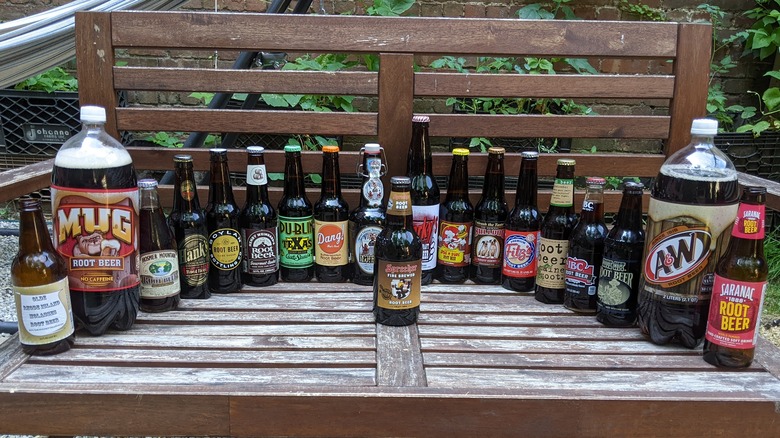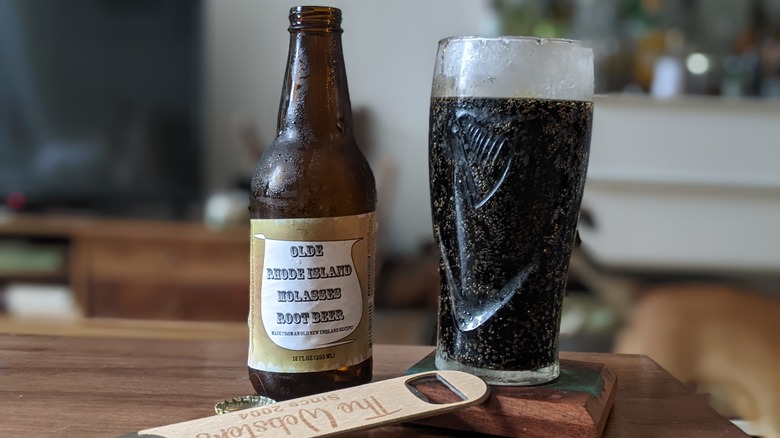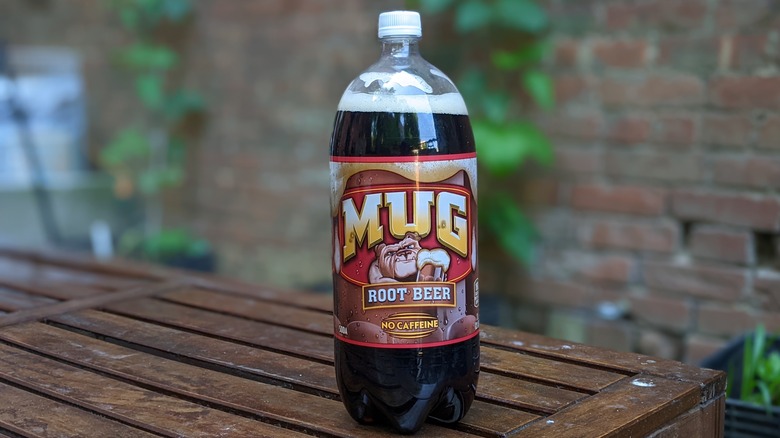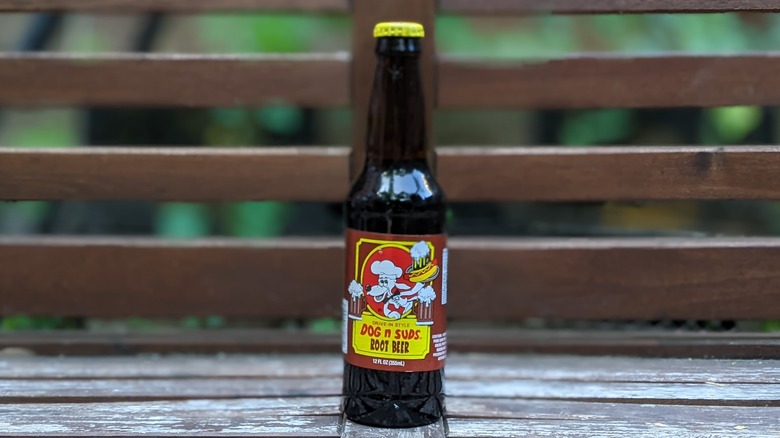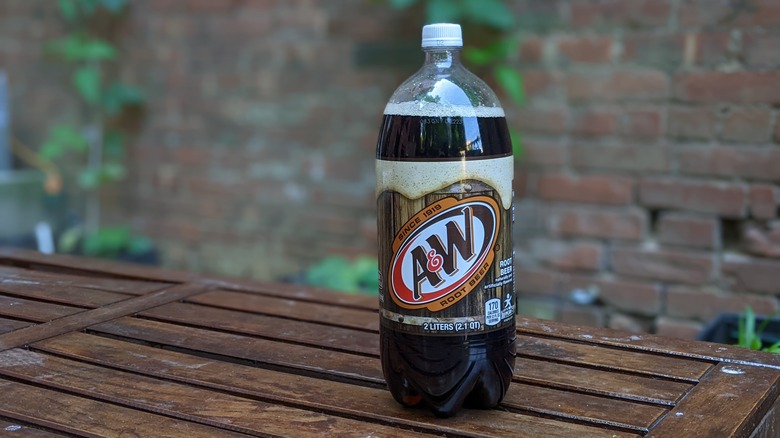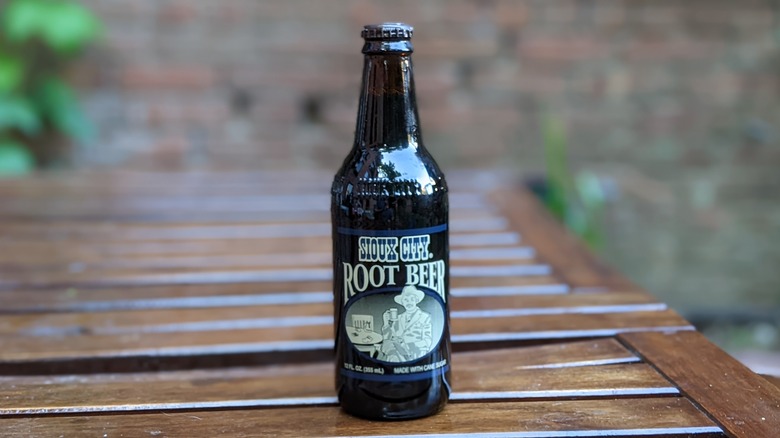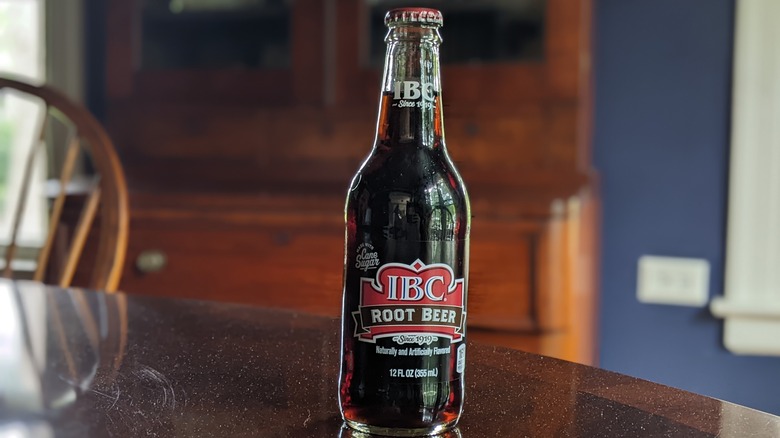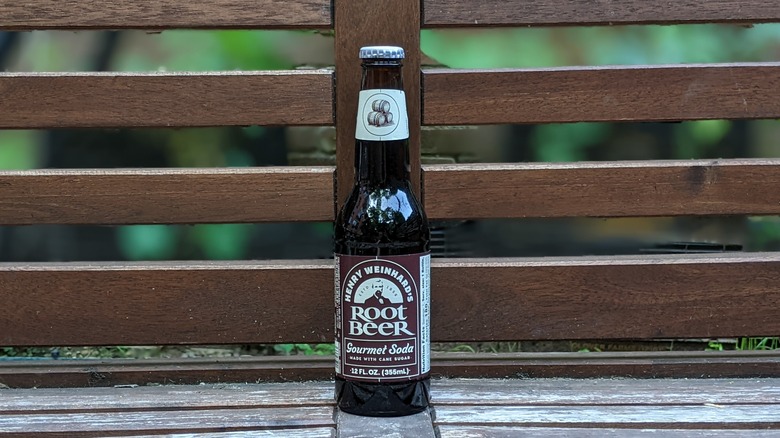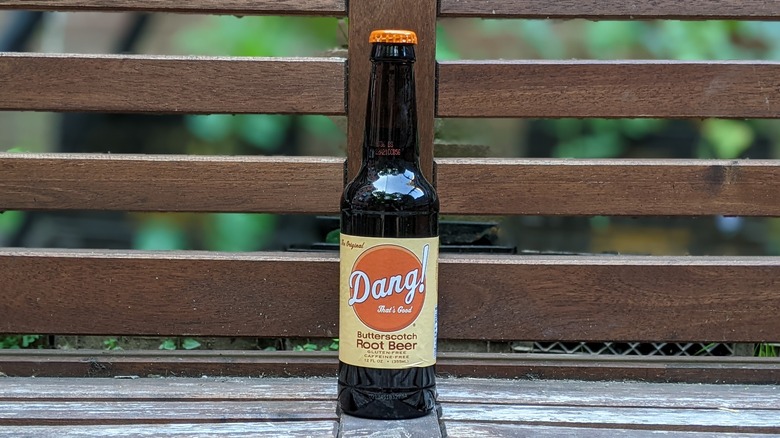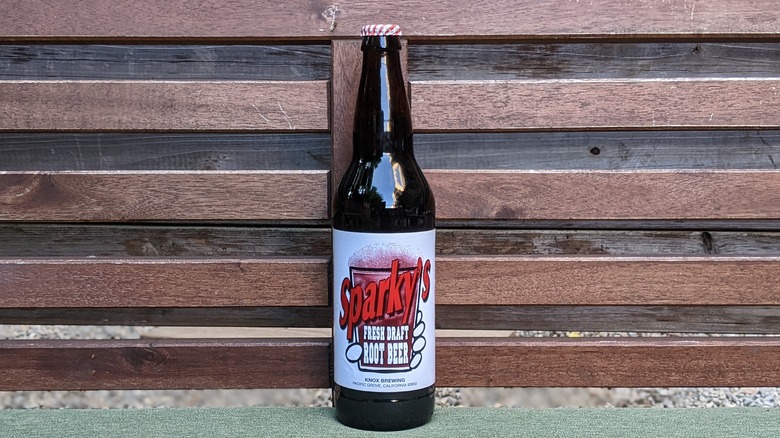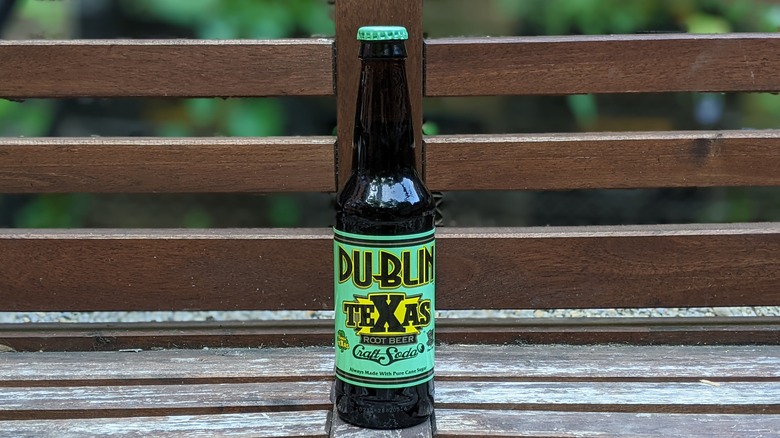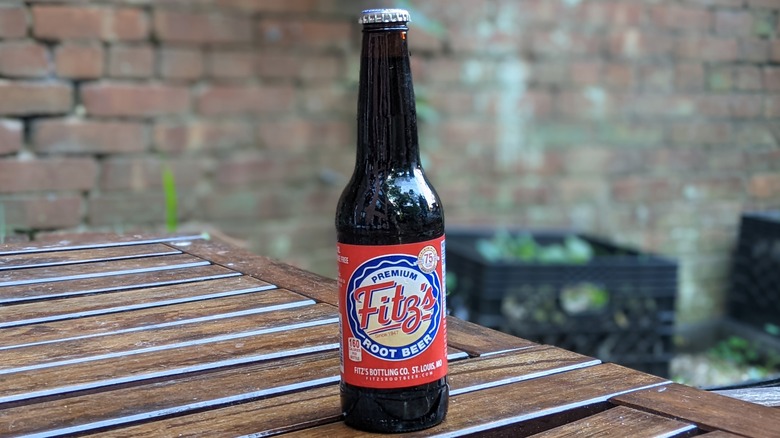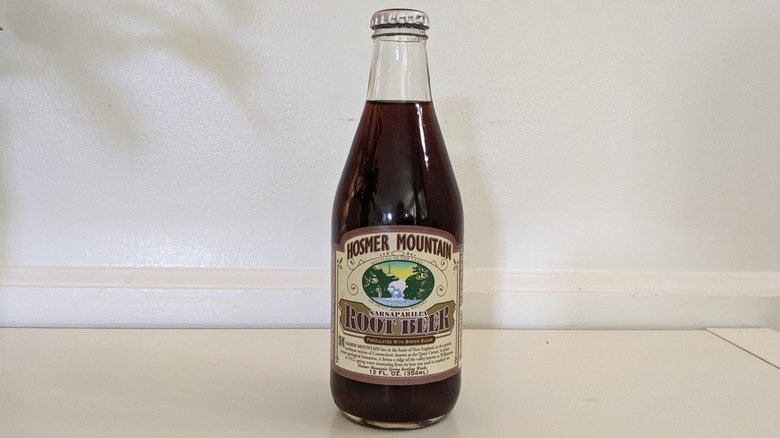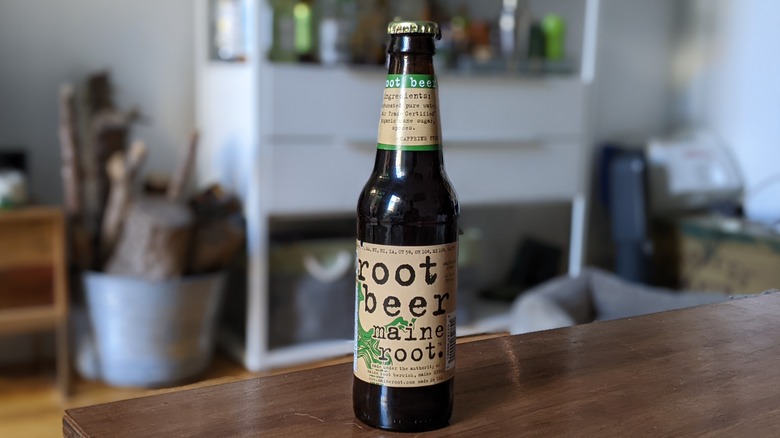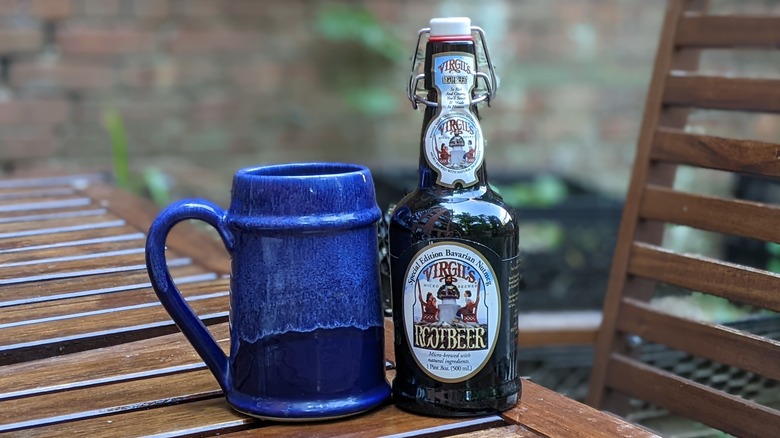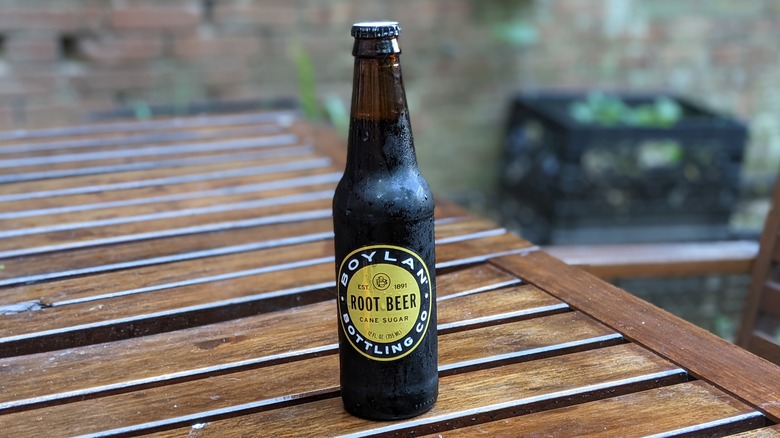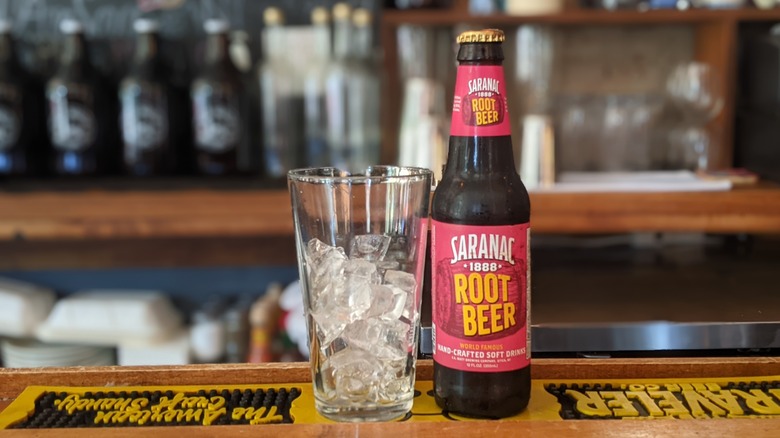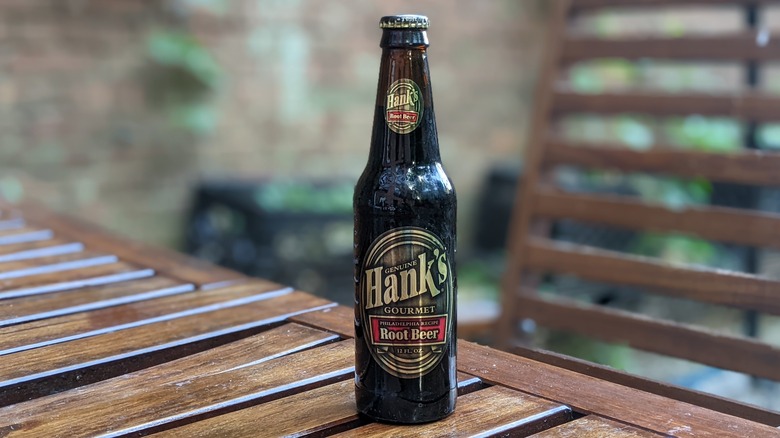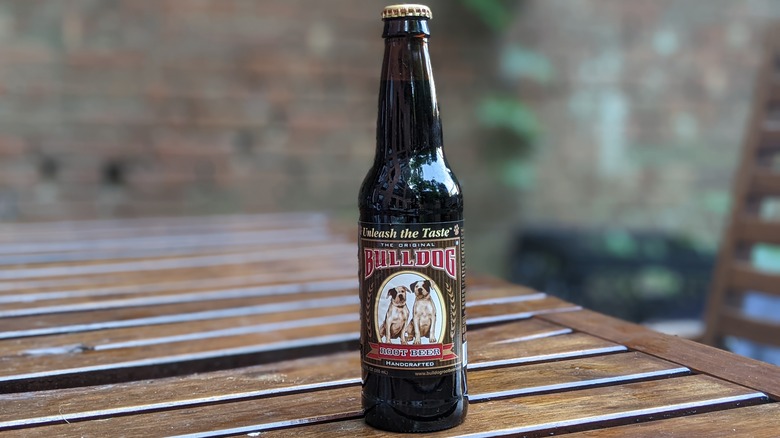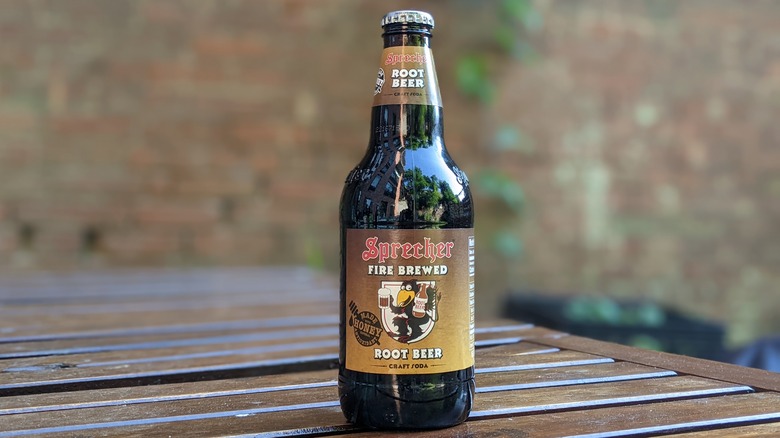The 19 Best Root Beer Brands, Ranked
There's no shortage of soda flavors, from beloved colas to esoteric concoctions, such as Rocket Fizz's ranch dressing soda. But for all that variety you'd be hard-pressed to name a flavor with more label options than root beer. Beloved by many for its complex mixture of spices, yet detested by others for the medicinal flavor of its origins in sarsaparilla tonic, root beer enjoys a devoted micro-culture like no other type of soda.
That's good news for you, the thirsty pop-soda-culture aficionado. It means almost endless options for root beers. Many are extremely high quality, crafted lovingly by devoted drinkers of the divine nectar, who sought to make the best possible version of its dark and rich flavor. Others are old family recipes, in production for decades from their origins as a homebrew served at hamburger stops and hot dog stands. But wherever they come from, the members of this list have one thing in common: They're some of the best root beers in America, and therefore the world.
When we talk about the best root beers, whiskey rules apply; we're speaking of the brands themselves rather than a single flavor. And while a majority of what we consider the best root beers are only available in a couple regions of the United States, we tried to ensure you could at least order them affordably wherever you live. We judged them on the main characteristics of root beer flavor (creaminess, spiciness, sweetness), texture (head, fizziness), and somewhere in between (bite).
19. Olde Rhode Island Molasses
Molasses is indeed the sweetener in this old recipe unearthed by Real Soda in Real Bottles, and produced by Empire Bottling Works in Bristol, RI, according to Five Star Soda's review. The wintergreen lands a haymaker with its first punch upon opening, to the point where the first taste is almost fruity. The nose is spicy and deep, which Kyle Drinks Root Beer found entrancing, but unfortunately the drink itself comes across stretched out. If you were inclined to be kinder to this inconsistent greatness, you'd echo Rob's Root Beer Review and call it silkiness, but in truth, it's like Olde Rhode Island used up all its energy in that first moment it hits your tongue. The spices can't do the work of a base that lacks rootiness.
Perhaps its biggest fault is the low carbonation that doesn't even stay the main. The fizzin a bottle of Olde Rhode Island Molasses can't even stick around for the duration of a 12 oz. glass pour. That's a shame, because Anthony's Root Beer Barrel review is right; you don't want to rush this one: Its relative wateriness is a curious combination with the intensity of the wintergreen, so it's preferable to sip and study. Regardless, Anthony recommends it up near the top of the scoring system, but reviews come in all over the map, and one wonders if this isn't a question of consistency from batch to batch or even top to bottom of the barrel.
18. Mug
Mug's been at the root beer game for a long time: Since 1940, according to the San Francisco Gate. Back then the Bay area-brew was Belfast Beverage Company's latest debut. Belfast itself had been producing fizzy drinks since 1877.
But Mug sits at the bottom of this list for its general unremarkability. Is it good? Good enough to rely on; you'd buy it before you'd grab the generic supermarket root beer. It's just hard to get excited about a root beer that, as The Soda Jerks says, lacks the creaminess of A&W (see below) or the bite of Barq's (which fell short of this list, sorry caffeine fans). Mug offers a vanilla-forward spice profile, but this, too, lacks any bold intensity to make a declarative dent in the competition. They rightly point out it's muted by its watery proportions.
Even its current owners don't seem too excited by this one. The landing page for this drink seems like its copywriter was Pepsi's third-best content bot, and its mascot is an unremarkable bulldog named... Dog. So yeah.
If you find yourself with some Mug, its best application, as noted throughout SheSpeaks, ChickAdvisor, and Influenster's user assessments, is as a base for a root beer float with a scoop of vanilla. There, its flavors pair beautifully and unobtrusively in the mixture, while the ice cream provides the extra oomph of sweetness and creaminess that Mug lacks. There, it's highly rated, perhaps because it's found its true calling.
17. Dog n Suds
Dog n Suds bills itself as the world's creamiest root beer, which is why it's extra-disappointing that Anthony's Root Beer Barrel assesses its draft style as wanting creaminess. While it's recommended for its taste, it's a sucker punch when your first reaction is it fails on the aspect billed as its strength.
Happily, there's also a drive-in style, which Anthony's Root Beer Barrel thought much more creamy and smooth with its caramelized overtones. My Root Beer Reviews and Root Beer Journal found the head on the drive-in very pleasing indeed, but all reviewers felt it could develop its taste more. Even then Kyan's Root Beer Barrel & Rob's Root Beer Reviews both felt the creaminess was still wanting. So while it doesn't carve out a strong identity so much as create a very pleasing threshold of root beer qualities, it does land here in the realm of the standard-bearers.
While you'd be well-advised to visit Dog n Suds at one of its many Midwest locations (though not nearly the 600-plus that once numbered the country) and try this root beer fresh in a frosted mug, the commercial version is more a bottle to sample (as an interesting and satisfying opportunity) than one best sought out. To put it simply: You'd buy it to try it if found in the wilds of the grocery store, but you wouldn't order it by mail unless you're a 1950s Fonzie dreaming of what nostalgia tastes like.
16. A&W
The first name in root beer brand recognition, A&W is so synonymous with the drink its product homepage URL is rootbeer.com. If you want to understand what people mean by creaminess and head, swig a mouthful of A&W and swirl its satin texture round your gob for a few moments before swallowing. It's a great starting point for what root beer should be like regardless of whether you feel it's what root beer should ultimately be.
As is the case with such things, true root beer-lievers often scoff at the top dog as nowhere near exemplary of the scene's greatness. But how many other root beers are running their own franchise network across America's highways? (Okay, fair point: Dog n Suds and B-K, we see you out there.) Since 1919, A&W restaurants will serve you fizzing root beer made fresh onsite, and according to Reader's Digest, actually invented the fast food model, outnumbering McDonald's as late as the '70s.
Now we wouldn't say that McDonald's ubiquity means it has the best burgers. We are saying, however, that you don't get to the top by accident. Like McDonald's, A&W's product focus is satisfaction rather than deep quality, and even their most ardent critics would probably put it above a dozen less preferable root beers no matter how much indie cred they sport. To back this up, Gourmet Root Beer reports that A&W restaurants serve a different and fresher recipe than the bottled version, worth seeking out.
15. Sioux City
White Rock Beverages' history rolls deep — all the way back to 1871, when pharmacist H.M. Colver began selling bottled sparkling spring water. In light of that, it's not all sloganeering when their Sioux City Sarsaparilla bottle says it's, "The granddaddy of all root beers." Regardless, their home brand of root beer is another cane sugar flagbearer but doesn't taste very sweet, according to The Root Beer Person. They found this bottle very mint-forward with a rich body, that nevertheless makes a diminished appearance in flavor and carbonation compared to the strong personalities on this list. Oddly, the same review also felt the flavor strengthens given a little time to settle.
The Soda Jerks said it emphasizes the bite more than the cream and feels that there's an aftertaste: one rather root-forward at that. All told, it may be most useful as the non-root-beer-drinker's-root-beer in its mildness. A strange brew, but an enjoyable one.
Others have found the flavor quite strong, in contrast, though with an absent aftertaste that may be another way of saying the strong body/weak flavor assessment above. It's also the first root beer in their list that earns a recommendation, though in some part, you feel like you're doing it for the history. It's rare enough not to pass up, but not so wondrous as to go seeking it out.
14. IBC
If you're going to drink a mainstream root beer, this is the one to get. IBC is creamy with a middling body and bite, which is likely why the nationally available brand earns a respectful nod from aficionados. While it does seem like IBC at its worst tends toward watery batches, more often the feeling and taste are satisfying from this cane sugar soda. The IBC recipe uses quillaia extract for a foamy head — since Soda Pop Extract explains that all the fizz in the world won't make froth if it doesn't cling a bit. In this, you can see the variance in a root beer's bubbliness and foaminess are what define its head.
The Root Beer Person reports that IBC debuted in 1919 like fellow legacy brand root beer A&W (though oddly not 1919-brand root beer, according to Heavy Table) — right around the time Prohibition went into effect. With beer suddenly forbidden, breweries needed a legal product to sustain them, and had all the equipment for soda. Smithsonian reports that some breweries turned to "near-beer," which was legally distinct, while a great many others dove into soda; that may explain why so many beer breweries produce root beer to this day.
Sprecher, which appears below, explains how root beer was an easy alternative, noting the irony of safrole's carcinogenic tendencies on the liver not yet being banned while offered as a healthy alternative to beer. Modern root beer foregoes sassafras, or uses extract devoid of safrole.
13. Henry Weinhard's
Many breweries pivoted into root beer during Prohibition. According to the folks at Henry Weinhard's, theirs stems from 1920, although Henry himself immigrated to the United States in 1851 and brewed beer. Blitz-Weinhard, still brewing beer, also produces this soda, but does it these days as a division of Molson Coors.
The Root Beer Person likes what's going on with Henry Weinhard's sassafras, vanilla, and honey, but wants more oomph at all levels, critiquing its most notable aspect as a pleasant bitterness supplanted with sweetness as a safety tether. Counterpoint: The Sodafry loves this beverage as bold, smooth, and a great pick for a root beer float, but laments its use of high fructose corn syrup in 2017.
What bumps it up a notch is this pour's renowned foaminess. Root Beer Reviews adores the unmatched head, recommending it as the best choice for a root beer float. Some root beers are great hosts for floats or cocktails because there's no personality there for the ice cream to overwrite; Henry's stands out for playing ball beautifully with a scoop of vanilla on a hot summer day.
And perhaps hearing the Sodafry's wish, Henry Weinhard's now uses cane sugar.
12. Dang! That's Good
Five Star Soda says Dang!'s recipe was already old when Jack Pettigrew founded Imperial Flavors in 1964. As per Peep THIS Out!, nobody's ever going to accuse the triple-hit combo of wintergreen, vanilla, and pure cane sugar of pulling their punches in a bottle of Dang!'s big, bold flavors. The root base also plays thick canvas to support this battle royal. This root beer has texture to match, with its strong fizz biting hard.
Whether that audacity is caveat or allure is the drinker's preference. The sweetness makes the back end of this one almost too sweet for Soda Guide, but The Frosted Mug recommends its balanced flavors as an exceptional drink for going beyond the stock and standard mug of root beer.
Okay, that said, let's talk about the real outlier: Dang! That's Good also makes a butterscotch root beer, which puts them in scant and shrinking company as purveyors of an ingredient combination that makes a knee-jerk sort of sense — then becomes a head-scratcher as you imagine eating butterscotch with wintergreen, mint, and anise. Not every soda can make the combo work — though reviewing Dang! Butterscotch, Gourmet Root Beer says it pulls off the difficult trick on that front, albeit by toning down its root beeriness perhaps a little too much. The site also says, "They sadly left the Body too hollow and the Bite too off for a Seal of Approval." Five Star agrees that the butterscotch could stand to share the stage more, but is very enjoyable as an unusual root beer.
11. Sparky's
Speaking of strong root beers: The wintergreen in this root beer kicks the door open, makes itself at home by flopping down on your tongue in a creamy vanilla manner, and then leaves with a milder mintiness. Reviewers echo "sharp" for the opening bite. Sparky's spiciness challenges drinkers to bring their hardiest tastebuds, and rewards those who do. Its sweeteners are a mixture of cane sugar and honey, which gives it two legs up on corn syrup sodas, which just don't hit the same way.
The Root Beer Store reports that this brew, named after founder Kevin Knox's cat, lacks foam compared to many pours, speculating that it likely eschews yucca or other agents to create texture. In that regard, its creaminess, devoid of head, is impressive. They also remark on its perceived birchiness or sarsaparilla base.
On the backend, Sparky's underlies its wintergreen cool with a mysteriously pleasant astringency. It's an unusual and memorable experience that departs from the baseline to wow a lot of connoisseurs and brewers in the know, like this Yelp reviewer of fresh-draft stuff, who says it harkens back to what root beer truly used to be like. Another recommends letting it sit so the carbonation blows off a bit if you find the mint too overpowering; it will weaken as the drink evens out, but long before it goes flat. Consider Sparky's a sipping root beer that will intrigue in new ways throughout a slowly consumed glass.
10. Dublin Texas
Much as Dog n Suds is a poor man's Saranac, Dublin Texas is an upper-middle-class man's Hank's. Okay, maybe that's unfair to this high-quality root beer. It's produced by the Dublin Bottling Works, formerly the Dublin Dr Pepper Bottling Company in the place where Dr Pepper was invented... until a contentious falling-out with corporate HQ, as reported at the time by The Dallas Observer and now a documentary called "Bottled Up: The Battle Over Dublin Dr Pepper."
The emergent story is the Dublin, TX plant remains devoted to making a quality product no matter what flavor soda you like. They have refused to cut corners (or corn syrups, in this case) in producing their cane-sugar sodas. The heritage of their Dr Pepper origins runs strong, so you can expect these folks to prioritize a quality beverage. So how's it taste?
The wintergreen and anise are center stage, which as always, is a draw for many, or a gauntlet for others. Oddly, Gourmet Root Beer finds such spice lacking even though it recommends this root beer. Rob's Root Beer Reviews cites the great half-life on this fizziness, staying sparkly from first to last. So you'll get bite in both texture and flavor. That review also cites the excellent bouquet when you crack the cap. Meanwhile, Root Beer Journal can't quite identify the so-so aftertaste, but isn't put off from its creamy body and great flavor.
9. Fitz's
The pride of the midwest root beer scene, Fitz's springs from its St. Louis microbrewery in the historic Delmar Loop. At its two locations, 19 soda flavors adorn a mouthwatering menu, including pumpkin and peach labels, but it's the locally devised 1947 root beer recipe that made this brand an anchor point upon the current Fitz's opening in 1993. Most of its root beer is served from the tap in the restaurant, and brewed onsite — but don't worry, you can order it sent to anywhere, right on their website. Brewery Tourist says they can crank out a bottle in a second, and do it to the tune of 10,000 bottles per day, while also reporting that the journey from draft to quaffing on the onsite pour is about three feet to refreshment.
Gourmet Root Beer, one of the harder reviewers to please, calls it a success any way you measure your root beer, and questions how it could have even fallen by the wayside originally. Thankfully, Fitz's is back now, with its original recipe and label, so it's like it never left.
My Root Beer Reviews loves how its vanilla and wintergreen spices wait in the wings until the appropriate moment to step forward. Steve's Root Beer Journal says that, without presenting a weak flavor, it's the one to grab when you want a drink that tastes the way the classic root beer should. It's root-forward, yet surprisingly light in taste despite all that. All in all, a fine drink.
8. Hosmer
No, you probably haven't heard of it, but this little entry from Connecticut's "Quiet Corner" placed fourth out of 89 entrants in 2004's Great American Root Beer Showdown. According to Hosmer Mountain Soda's production blog, they've been at the soda game since 1912, currently offering 30 beverages. But it was their root beer that put them right up at the top along with the original root beer, Hires. (RIP until Dr Pepper comes to its senses and brings back the O.G.)
The Soda Jerks adore Hosmer Mountain's outlying use of brown sugar in its recipe, claiming it's the secret weapon in an arsenal that includes a root-centric flavor profile, while casting about for anything negative to say and coming up all but empty. The real secret, according to Hosmer's product designer and flavorist Bill Potvin — commenting on Anthony's Root Beer Barrel — is the extract of sarsaparilla root, which few root beers or sarsaparilla sodas still use. Then again, it might be Hosmer's base of chlorine-free, mineral-rich, natural well water. With an exemplary soda like this, every key difference seems like a clue to its quality, when in truth, it's most likely an aggregate of all these factors.
One Bad Veggies Root Beer Review salutes this label as serving up the longest-lasting head of any root beer in its stable of reviews, and the perfect amount of bite, while echoing the affection for the prominent brown sugar taste. Gourmet Root Beer relishes the bite and head as well. Solid victory.
7. Maine Root
Widely hailed for all its flavors, Maine Root's focus nevertheless remains the root beer that named the company. When founder Matt Seiler was working at a pizza shop in Portland, ME, he wanted sodas that matched the natural specs of the food. He crafted a root beer using cane sugar rather than corn syrup; The Atlantic reports that cane sugar is more expensive than corn syrup because of trade tariffs, but Maine Root insists on it for quality while only using certified fair-trade sugar to benefit the farmers harvesting it. Maine Root even helps build schools and hospitals among its suppliers' communities.
All of which is wonderful, but only when the product is worth buying. With a preservative-free, three-ingredient label list, you have to marvel at Maine Root's ability to wring such a wonderful drink out of water, sugar, and spices. The Soda Jerks admire how centrally placed the profile is, with creaminess and sweetness chasing the initial fizz and fog of a lovely head. That's when the mint and anise tread to center stage on light steps.
If there's a flaw in this workhorse making magic out of simplicity, it's like Gourmet Root Beer says: "The only drawback is the almost complete lack of bite and that something extra, like honey or cinnamon, to really seal the deal."
6. Virgil's
Listen to the wise assessment of The Frosted Mug: Virgil's is the utmost love-it-or-hate-it entry on this list, with many — like this Redditor — finding its anise and wintergreen notes medicinal, while others adore its complex spices as proof of its recently retired label depicting divine deliverance. One even finds reviewers like Anthony's Root Beer Barrel, which went from calling it the fourth-worst root beer in the site's experience to begrudgingly recognizing magnificence upon second tasting. So that's the span we're dealing with: Root beer critics even disagree with themselves about Virgil's proximity to root beer ideals.
Now if that contention were the whole story, Virgil's would land lower on this list to acknowledge the limitations of many folks' tastes in the face of overclocked spice greatness. But original is not the only flavor cooking in the Virgil's kettle. The brand also puts out Virgil's Bavarian Nutmeg Root Beer, which is widely recognized as great, even among naysayers of the standard stuff, such as Gourmet Root Beer. And The Root Beer Person recommends it for dialing back the anise and amping up the molasses.
Moreover, Virgil's makes what's widely considered the best of the zero-sugar root beers, since a lot of people despise the synthetic non-sugar sweeteners that most sodas use. LA-Story calls the main brand her root beer holy grail, and gushes over Virgil's sugarless version, which combines erythritol, stevia, and monk fruit in its proprietary sweetener blend as having unlocked the secret to sugar-free flavor without chemical undertones.
5. Boylan
Remember that Great American Root Beer Showdown that Hosmer placed fourth in, above? Well Boylan won it flat-out with its minty, cinnamon, light flavor described as not too sweet, which belies its sugar at 43 grams per bottle, at the high end of the standard. Though it's obviously well-regarded in all quarters, Boylan's rise as a premium soda brand comes very late in the game for a producer hailing back to 1891. Their deservedly beloved birch beer is the flagship, but where there's birch beer, root beer and cream sodas are never far behind.
These three flavors — and to a lesser extent, black cherry, recur in any discussion of the brand's lineup, making such a name for Boylan that it has led food reviewers like Southern Food Junkie to ask if it's the best soda.
Now as for the root beer itself, it's a cane sugar product, which is a definite theme on this list. You don't think of it as a particularly foamy root beer, and the fizz settles fairly quickly, but it does have yucca extract for textural effects. The Soda Jerks detect an unusual, beerlike quality, an assessment shared by Kyan's Root Beer Barrel (though it tested poorly there), where smell and taste of beer shine through. That suggests that there's yeasty fermentation going on at some point, but whether the beeriness is why this root beer is so widely hailed or not, Boylan makes it quite plain that their products contain no alcohol.
4. Saranac
Saranac Brewery (really F.X. Matt Brewing) boasts that only a true brewery can make the natural strong head that their root beer displays, and whether or not that's true, they can't make a bad beer, and since 1995 Saranac has made a very good root beer. Saranac 1888 is a perennial medalist in the non-alcoholic category at the U.S. Open Beer Championship (it took silver in 2021).
Though its 1888 beer and root beer officially commemorate the local train line's centennial, that's also the year this spectacular slinger of beverages converted into its modern form. They're another member of the legion of Prohibition-era breweries that discovered they were pretty good at this soda game. The Sodafry recommends it in conjunction with hearty pub and pizza fare, and boy does this have the body for it.
But about that head: Oh yes, it is rich and foamy and just perfectly hearty, stopping short of fulsome. The vanilla comes at you strong, and you'd be hard-pressed to name a better root beer for swigging and swishing. You don't drink it fast, and you let it hang out on the tongue a bit to show you all of its tricks. It's not just a hardbody: This brew has personality in its wintergreen, anethol and sassafrass traits.
Unusual in the craft and enthusiast root beer scene, Saranac uses high-fructose corn syrup.
3. Hank's
If you like creamy root beers, Hank's is your beverage. If you don't like creamy root beers, go drink lesser soda, heretic — wait, come back, that was unfair. Still, Hank's may just be root beer's best combo of creaminess, body, and rich, smooth feeling with a spicy flavor and aroma. The vanilla-forward soda was a Top 10 placer at the Great American Root Beer Showdown.
The (what else?) cane sugar root beer is a Philadelphia favorite that just celebrated a quarter century of root beer production, along with some truly interesting, unique varieties like pumpkin spice and caramel apple cream. Its root beer is spoken of with reverence among the cognoscenti. Anthony's Root Beer Barrel likes its exceptional caramel tones, while stopping just short of calling it the platonic form of what a craft microbrew root beer should be.
Craft Beverage Jobs, while wishing the carbonation came in stronger, enthuses readers about its nose and palate, giving its scent and taste top marks at twin nines out of 10. When the folks who report on the craft beverage industry say they've never smelled a better bouquet in a root beer, trust the research.
You may have to hunt around to find Hank's on shelves: Even when Hank's store locator finds a supermarket that carries it, root beer might not be in stock. So here's a tip from Gourmet Root Beer: Search your hardware store (at least Hardware Hank) for tie-in promo bottles.
2. Bulldog
Bulldog tries harder and is justifiably proud of its dedication to perfection. With pure vanilla (no vanillin here!) and a devotion to old methods of preparation that create more complex flavors, you'd be well-advised to follow the company's advice on consumption (chilled, no ice) to fully enjoy the volatile honey and vanilla presence that they've so thoughtfully kept light on carbonation to preserve. After all, this is a company that spent two years testing nine different recipe batches.
My Root Beer Reviews says the real vanilla used in this recipe makes all the difference, but with cane sugar and honey tag-teaming in the sweetness ring, Bulldog presents an above-the-grade drinking experience regardless. Maltodextrin in the recipe helps sweeten a little as well, but The Kalamazoo Gazette explains its real value is helping to create fizz and satisfying foam. That's probably why it draws a comparison to Henry Weinhard's, even if the foaminess doesn't go so wild.
Anthony's Root Beer Barrel ranks Bulldog as the very best root beer in not one but two reviews, with only high praise for its perfect embodiment of all that a root beer should be in taste, texture, fizziness level, and finish. As noted in Anthony's original review, honey can be a challenge for soda brewing, but those labels that conquer its nuance, the brew attains a higher level of joy on your tongue than refined sugars can reach. The Soda Jerks corroborate by placing Bulldog at the forefront of 30 reviewed root beers.
1. Sprecher
Here it is. The top dog... or griffin, as the case (of root beer) may be. From the mighty fires of Sprecher Brewing in Glendale, WI springs the honey-sweetened and malted root beer nectar of the gods. You might have seen a bottle cameo recently in FX's buzzy The Bear, or maybe you're lucky enough to catch it in a permanent seat of honor on your root beer shelf.
And yes, Sprecher really is fire-brewed! Like Bulldog, it makes use of honey and maltodextrin under more standard sweetener to give this brew a truly wonderful topography of flavors hosting a flora of foam. Rich and creamy were devised as words to accurately describe this soda.
As if that weren't lovely enough, Sprecher makes a maple root beer, too, and Gourmet Root Beer reports they've recently launched a vanilla label as well, meaning folks who like their nuance from sweetness have one option, while those who seek it in spice can go the other way.
Root Beer Reviews calls this king the very example of a "good root beer": Smooth, complex, and as enjoyable on its own as it is maintaining its identity in a root beer float. And while lavishing it with praise, The Sodafry places particular emphasis on a finish so soft and dense you could probably soundproof a recording studio with it. No wonder that griffin has a raven's head; the root beer he mascots for is something to crow about.
